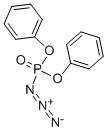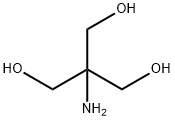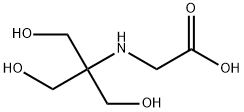Bromo-tris-pyrrolidino-phosphonium hexafluorophosphate
Synonym(s):Bromo-tris-pyrrolidino-phosphonium hexafluorophosphate;PyBroP
- CAS NO.:132705-51-2
- Empirical Formula: C12H24BrF6N3P2
- Molecular Weight: 466.19
- MDL number: MFCD00077412
- EINECS: 620-834-4
- SAFETY DATA SHEET (SDS)
- Update Date: 2024-11-25 20:05:57

What is Bromo-tris-pyrrolidino-phosphonium hexafluorophosphate?
Chemical properties
white to off-white powder
The Uses of Bromo-tris-pyrrolidino-phosphonium hexafluorophosphate
A stable reagent for the coupling of N-Methylamino acids in peptide synthesis.
The Uses of Bromo-tris-pyrrolidino-phosphonium hexafluorophosphate
It can be used as a coupling reagent:
- For Suzuki–Miyaura cross-coupling of phenols and arylboronic acids to synthesize biaryls and heterobiaryls.
- To functionalize pyrimidines (synthesized from 3,4-dihydropyrimidin-2(1H)-ones (DHPMs) via the Kappe dehydrogenation) by using various nucleophiles.
- To synthesize formamidines by coupling with various primary amines and N,N-diisopropylethylamine.
It can also be used as an activating reagent:
- For the activation of C-OH bond in tautomerizable heterocycles to form the phosphonium salt which aids the Sonogashira coupling of heterocycles with various alkynes.
- For the one–pot activation of C-O bond in phenols and further coupling reaction with phosphine oxide or phosphite to form C-P bonds.
Properties of Bromo-tris-pyrrolidino-phosphonium hexafluorophosphate
| Melting point: | 100 °C |
| storage temp. | -20°C |
| solubility | DMF: 0.4 g/mL, clear |
| form | Powder |
| color | White to off-white |
| Water Solubility | moderately soluble |
| Sensitive | Moisture Sensitive |
| BRN | 7845702 |
| Stability: | Moisture Sensitive |
| CAS DataBase Reference | 132705-51-2(CAS DataBase Reference) |
Safety information for Bromo-tris-pyrrolidino-phosphonium hexafluorophosphate
| Signal word | Danger |
| Pictogram(s) |
 Corrosion Corrosives GHS05 |
| GHS Hazard Statements |
H314:Skin corrosion/irritation |
| Precautionary Statement Codes |
P260:Do not breathe dust/fume/gas/mist/vapours/spray. P280:Wear protective gloves/protective clothing/eye protection/face protection. P363:Wash contaminated clothing before reuse. P303+P361+P353:IF ON SKIN (or hair): Remove/Take off Immediately all contaminated clothing. Rinse SKIN with water/shower. P305+P351+P338:IF IN EYES: Rinse cautiously with water for several minutes. Remove contact lenses, if present and easy to do. Continuerinsing. |
Computed Descriptors for Bromo-tris-pyrrolidino-phosphonium hexafluorophosphate
| InChIKey | CYKRMWNZYOIJCH-UHFFFAOYSA-N |
New Products
(S)-3-Aminobutanenitrile hydrochloride 4-Methylphenylacetic acid N-Boc-D-alaninol N-BOC-D/L-ALANINOL Tert-butyl bis(2-chloroethyl)carbamate 3-Morpholino-1-(4-nitrophenyl)-5,6-dihydropyridin- 2(1H)-one Furan-2,5-Dicarboxylic Acid Tropic acid 1-Bromo-3,5-Di-Tert-Butylbenzene S-2-CHLORO PROPIONIC ACID ETHYL ISOCYANOACETATE 2-Bromo-1,3-Bis(Dimethylamino)Trimethinium Hexafluorophosphate 4-IODO BENZOIC ACID 3-NITRO-2-METHYL ANILINE 1-(2,4-DICHLOROPHENYL) ETHANAMINE (2-Hydroxyphenyl)acetonitrile 4-Bromopyrazole 2-(Cyanocyclohexyl)acetic acid 4-methoxy-3,5-dinitropyridine 1-(4-(aminomethyl)benzyl)urea hydrochloride 2-aminopropyl benzoate hydrochloride diethyl 2-(2-((tertbutoxycarbonyl)amino) ethyl)malonate tert-butyl 4- (ureidomethyl)benzylcarbamate Ethyl-2-chloro((4-methoxyphenyl)hydrazono)acetateRelated products of tetrahydrofuran

![5-Chloro-1-[bis(dimethylamino)methylene]-1H-benzotriazolium 3-oxide hexafluorophosphate](https://img.chemicalbook.in/CAS/GIF/330645-87-9.gif)






You may like
-
 Bromotripyrrolidinophosphonium Hexafluorophosphate CAS 132705-51-2View Details
Bromotripyrrolidinophosphonium Hexafluorophosphate CAS 132705-51-2View Details
132705-51-2 -
 Pybrop 97% CAS 132705-51-2View Details
Pybrop 97% CAS 132705-51-2View Details
132705-51-2 -
 PyBroP CAS 132705-51-2View Details
PyBroP CAS 132705-51-2View Details
132705-51-2 -
 Bromotripyrrolidinophosphonium hexafluorophosphate CAS 132705-51-2View Details
Bromotripyrrolidinophosphonium hexafluorophosphate CAS 132705-51-2View Details
132705-51-2 -
 1975-50-4 98%View Details
1975-50-4 98%View Details
1975-50-4 -
 2-HYDROXY BENZYL ALCOHOL 98%View Details
2-HYDROXY BENZYL ALCOHOL 98%View Details
90-01-7 -
 14714-50-2 (2-Hydroxyphenyl)acetonitrile 98+View Details
14714-50-2 (2-Hydroxyphenyl)acetonitrile 98+View Details
14714-50-2 -
 118753-70-1 98+View Details
118753-70-1 98+View Details
118753-70-1
Statement: All products displayed on this website are only used for non medical purposes such as industrial applications or scientific research, and cannot be used for clinical diagnosis or treatment of humans or animals. They are not medicinal or edible.